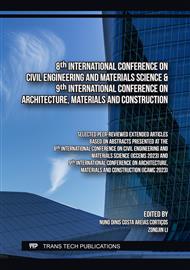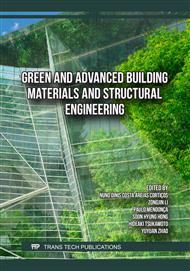p.25
p.33
p.43
p.49
p.55
p.61
p.71
p.79
p.87
Tensile Strength Determination for Rice Husk Ash and Corn Cob Ash Blended Cement Concrete
Abstract:
This study concerns the determination of the tensile strength of concrete produced by partially replacing cement with rice husk ash (RHA) and corn cob ash (CCA). The tensile strength of RHA and CCA blended cement concrete and its suitability as sustainable green concrete materials were investigated. Cubes of 100x 100 x 100 mm unmodified concrete (pure cement) and modified concrete (cement, RHA and CCA) were cast using a mix ratio of 1:2:4 containing binder (cement, RHA, CCA), sand, and coarse aggregate. Physical properties (moisture content, grain size analysis and specific gravity) of RHA and CCA, the effect of curing age and the effect of varying percentage replacement of cement with RHA and CCA blended cement concrete on the tensile strength of concrete were investigated. The varying replacement of cement with RHA and CCA were 0% (100% Cement), 10% (5% RHA, 5% CCA, 90% Cement), 20% (10% RHA, 10% CCA, 80% Cement), 30% (15% RHA, 15% CCA, 70% cement) and 40% (20% RHA, 20%CCA, 60% cement). The tensile strength of the 1:2:4 concrete mix of the unmodified concrete at 28 days strength was valued to be 3.39 N/mm2 while that of modified concrete of 10%, 20%, 30% and 40% RHA, and CCA are 3.30, 2.74, 2.69 and 1.63 N/mm2 respectively, showing that tensile strength of concrete decreases with an increasing amount of RHA and CCA and increases with an increasing number of curing age. This research suggests that RHA and CCA concrete of 10% can be used to produce concrete for structural members, while 20%, 30% and 40% of concrete can be used for weak concrete where filling and other minor works are required.
Info:
Periodical:
Pages:
55-60
Citation:
Online since:
December 2023
Price:
Сopyright:
© 2023 Trans Tech Publications Ltd. All Rights Reserved
Share:
Citation:



